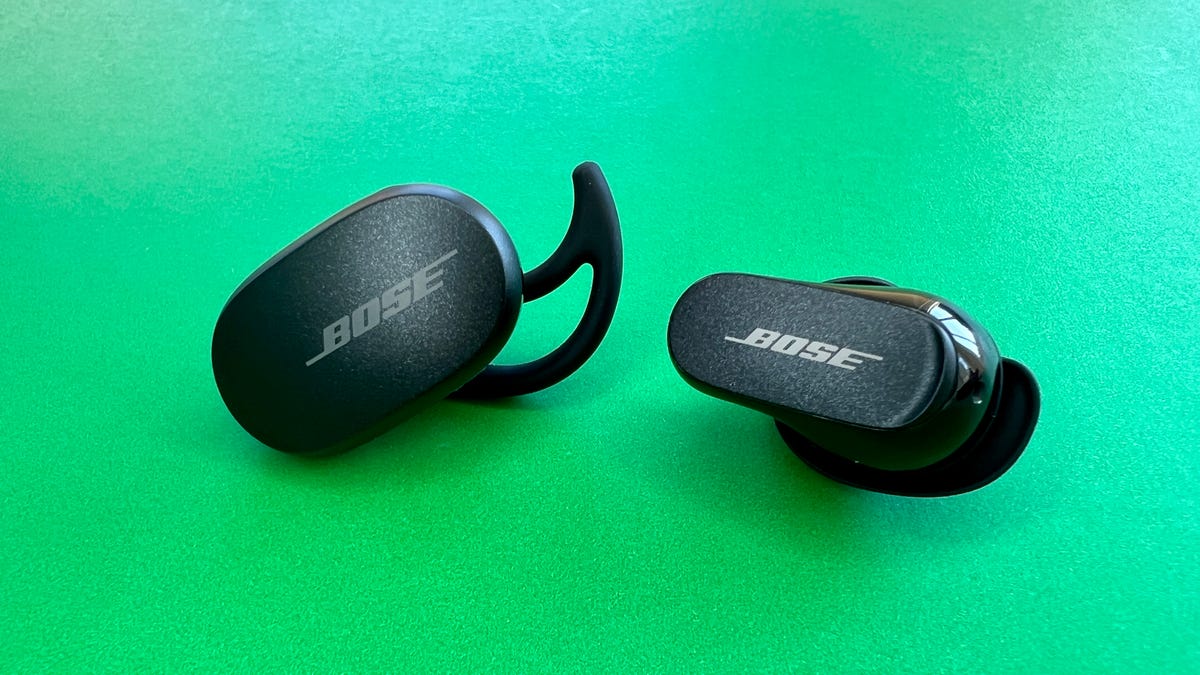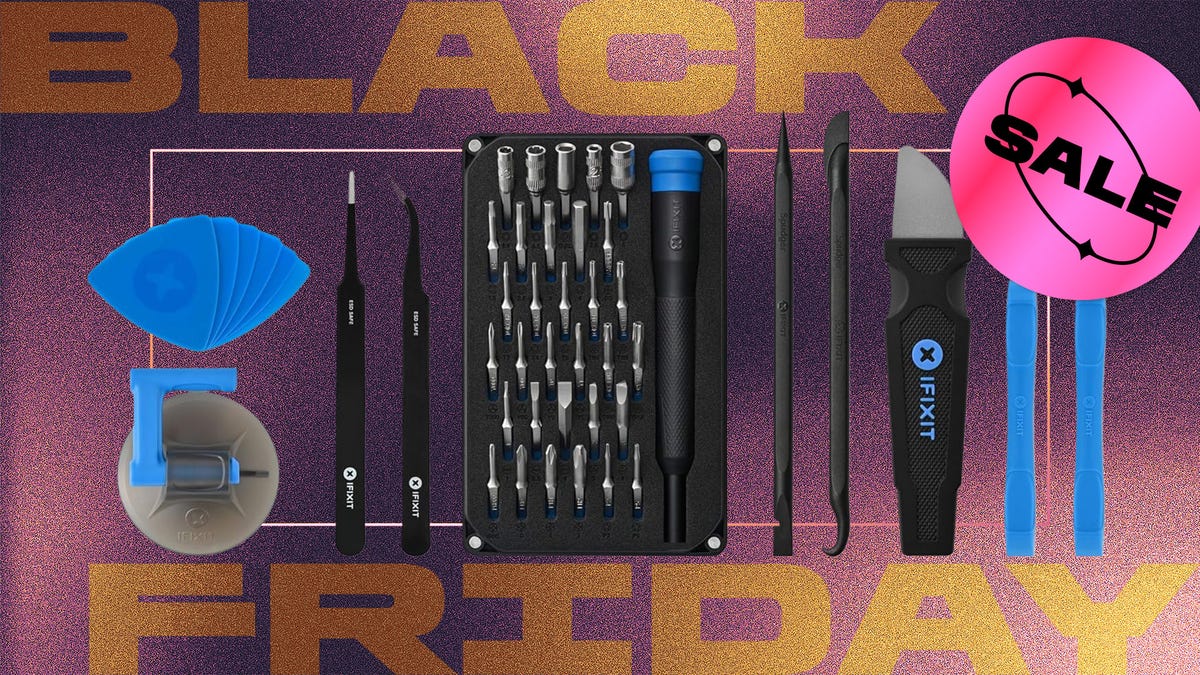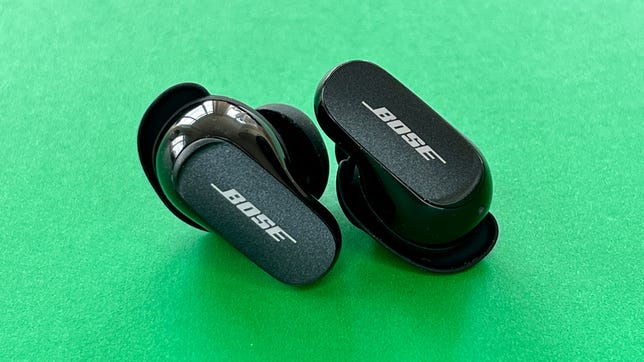Technologies
Bose QuietComfort Earbuds 2 Review: Best Noise Canceling, Bar None
Sony and Bose have been battling it out for noise-canceling supremacy the last few years. Bose has taken the lead once again with its $300 flagship earbuds.

Bose headphones and earbuds have always skewed toward the more premium end of the price spectrum and the company’s QuietComfort Earbuds 2 are no exception, carrying a hefty list price of $299 ( 279, $AU429), or $20 more than the original QuietComfort Earbuds. While that will put them outside a lot of people’s budget for wireless earbuds, their design and voice-calling performance are significantly improved from the originals, and they deliver excellent sound and outstanding noise canceling — arguably the best out there right now. They’re easily among our top current earbuds, and a CNET Editors’ Choice Award winner.
That award came a few months after the release of the QuietComfort Earbuds 2 after some internal debate — most notably the earbuds’ missing support for the AptX Adaptive audio codec that’s compatible with many Android phones and some other devices. But Bose has since announced that AptX support will be added in the spring of 2023. «The QuietComfort Earbuds 2 will support the AptX Adaptive codec for audio streaming, including Lossless and low-latency capabilities,» Bose told CNET, «and enable more seamless and robust connectivity with premium Android devices.»
I’ll save that value debate for the end of the review after I go through all QuietComfort Earbuds 2’s strengths (or QuietComfort Earbuds II, as Bose calls them), along with a few weaknesses. But if you can afford them, these are certainly strong competitors against Apple’s AirPods Pro 2 and Sony’s WF-1000XM4, the latter of which have been out for a while and are being aggressively discounted at times.
Read more: Best Wireless Earbuds for 2022
Like
- Excellent sound and best-in-class noise canceling
- Significantly smaller than their predecessors
- New Fit Kit ear tips and stabilizer system gets you a secure, comfortable fit
- Improved voice calling with better noise reduction
Don’t Like
- Pricey
- No wireless charging
- No multipoint Bluetooth pairing
- AptX support not coming until spring 2023
Product details
- Battery Life Rated Up to 6 Hours
- Noise Canceling Yes (ANC)
- Multipoint No
- Headphone Type Wireless Earbuds
- Water-Resistant Yes (IPX4 — Splash-Proof
Initially the buds were only available in black — or «Triple Black,» as Bose calls it, but you can now also get the in the lighter soapstone color (basically off-white) and it’s possible Bose releases other special-edition colors in the future.
More importantly, the earbuds are about 30% smaller than their predecessors. Their case is about 40% smaller and truly pocketable (though it’s still about 25% to 30% bigger than the AirPods Pro 2’s case). The smaller size corrects a big downside of the original QuietComfort Earbuds, which featured excellent noise canceling and very good sound quality, but were pretty hefty and protruded from your ears. The new buds each weigh a little less than 0.25 ounces, or 7 grams, according to Bose — still not svelte but significantly smaller.
The other big change is to the ear tips. Bose has ditched its one-piece StayEar wing tips for a two-piece Fit Kit system that features separate ear tips and «stability bands» in three size options. That’s supposed to give users more flexibility to get a secure fit and tight seal. I liked the StayEar wing tips, but after trying the new two-piece system, I’m sold on it. I ended up going with the large tips and medium stability band, and that really locked the buds in my ears. I can’t tell you that this will fit everyone’s ears equally well, but if you’re someone who can’t get a secure fit with the AirPods Pro 2, which are lighter and quite comfortable to wear, this new two-piece Fit Kit may be a reason to give the Bose a go over the new AirPods Pro.
A handful of new premium earbuds feature a kind of auto custom tune feature that takes into account the shape of your ears — and ear canal. Following that trend, Bose has developed a new CustomTune sound calibration system that aims to optimize noise canceling and sound quality for your particular ears. Every time you place the buds in your ears, a proprietary tone is played and a microphone measures your ear canal’s acoustic response. It takes about half a second or so and you definitely notice that the noise canceling has undergone some optimization.
While the design improvements are a nice step forward, the QuietComfort Earbuds 2 really shine on the noise canceling front. It’s really impressive just how much the sound around you is muffled. Bose says it’s targeted frequencies that were previously difficult to reduce in the mid and high range, like the voices of nearby co-workers, screaming babies and family distractions in your home office. I used the buds in my home next to a relatively loud HVAC unit, and the noise canceling basically silenced it completely.
But I was more impressed with how much sound it reduced when I walked the streets and rode the subway in New York City. You can still hear people’s voices, but they seem to be muffled by about 60% and maybe even slightly more. It’s a little startling when you take the buds out of your ears or put them into transparency mode — Bose calls it Aware mode — and realize how much sound is being filtered out.
And yes, that transparency mode is also improved — it does sound more natural and lifelike. The best transparency modes, like that of the AirPods Pro, make it seem as if you’re not wearing earbuds and can hear the world as it would sound without earbuds in your ears. These do a good job of getting you close to that sensation.
While the drivers appear to be the same or very similar to those found in the original QuietComfort Earbuds, Bose reps told me that thanks to the CustomTune technology, the sound is noticeably improved, with more «nuance, clarity, depth» and better accuracy. And that’s pretty much what you’ll hear if you were to compare these to the originals. Everything is a little more clear and natural sounding. Their predecessors also had relatively big sound — and by that I mean they have a pretty wide soundstage. But the bass has a bit more definition and punch, and there’s a bit more detail and separation between instruments so you can hear them more distinctly. I also thought they had just the right amount of warmth, particularly with both men’s and women’s vocals. Their tonal balance is overall very good.
While software and advanced algorithms play a big part in the QuietComfort Earbuds 2’s performance, they feature four microphones in each bud, two of which are beam-forming microphones to focus on picking up your voice. Voice-calling performance was a weak point in the original QuietComfort Earbuds and Bose has clearly made an effort to improve it with better noise reduction — and voice pickup — during calls. I think it’s significantly better now (you can hear a sample call in my companion video review).
As for battery life, it’s rated at 6 hours with noise canceling on — that’s the same as the new AirPods Pro 2 — and you get about three extra charges from the new trimmed-down charging case, which features USB-C charging but not wireless charging. That latter shortfall is a bit unfortunate since most earbuds in this price range, including the AirPods Pro 2, feature wireless charging.
Like their predecessors, the QuietComfort Earbuds 2 are splash-proof with an IPX4 rating. They also have similar touch controls with a swipe gesture for volume control that I like. I thought the touch controls worked well, and they are slightly customizable in the companion app for iOS and Android (you have the option to select certain «shortcuts»).
As for Bluetooth flavors, these are equipped with Bluetooth 5.3. They use the AAC and SBC audio codecs but currently have no support for Qualcomm’s aptX Adaptive audio codec or multipoint Bluetooth pairing (I manually switched between an iPhone 13 Pro and a Galaxy Z Flip 4). In theory, you may be able to get slightly better audio quality if you use a device like an Android phone that supports aptX Adaptive and wirelessly stream high-resolution music files using services like Tidal, Amazon Music and Qobuz that deliver high-resolution music.
I was disappointed by that, particularly by the lack of multipoint Bluetooth pairing. But there’s some hope that may change in the future. That’s because a Bose rep told me these earbuds are equipped with a 5 Series Qualcomm chip. That chip supports multipoint Bluetooth pairing and has aptX support, which Bose now says is coming in 2023, so I think there’s a decent chance we’ll see multipoint Bluetooth pairing added in the future and perhaps other features. Bose didn’t mention anything about Bluetooth Audio LE and Auracast, a new Bluetooth audio broadcasting technology that’s coming to earbuds and headphones, but some new earbuds like the Samsung Galaxy Buds 2 Proare listed as being «ready» for LE Audio.
It’s worth noting that while the noise canceling is of the adaptive variety, you can adjust its levels between three settings. Also, the earbuds have adjustable equalizer settings so you can tweak the sound profile. And finally, you can use a single bud independently and leave the other one in the charging case though certain touch controls are available only on the right bud.
Bose vs. Sony, Beats and AirPods Pro
I’ll finish by saying that I did compare these to some other top earbuds, including Sony’s WF-1000XM4, which were released in June 2021 and list for $20 less. The XM4s are still excellent, but these QuietComfort Earbuds 2 have surpassed the Sony buds not only in terms of sound quality and noise canceling but voice calling and fit as well. The Bose buds are superior.
I also like the Beats Fit Pro ($200) for both everyday use and as sports earbuds (they also stay in my ears very securely). They’re probably the better value, particularly as we’re starting to see regular discounts on them. But the Bose offer better overall performance along with a comfortable, secure fit in comparably sized earbuds.
Apple’s AirPods Pro 2, which also earned a CNET Editors’ Choice Award, are lighter and smaller and deliver impressive overall performance in a smaller package (that includes the charging case, which does feature wireless charging). But if you’re someone who can’t get a really secure fit from the AirPods Pro — or are an Android user — these are a compelling alternative. That said, the performance improvements to the AirPods Pro 2 make them a pretty safe and enticing choice for iPhone users for $50 less than the Bose. That doesn’t mean you shouldn’t consider the QuietComfort Earbuds 2 if you’re an iOS user, but the AirPods Pro have their own set of advantages for iOS users, including spatial audio, automatic switching between your Apple devices on your iCloud account and hands-free Siri.
The same can be said for Samsung’s excellent Galaxy Buds 2 Pro buds and Samsung Galaxy device owners. Those buds have certain features that only Galaxy owners can take advantage of, including high-resolution audio over Bluetooth if you have the right setup.
But again, the QuietComfort Earbuds 2 may offer a better fit for you, and I do think they sound a touch better than both the Galaxy Buds 2 Pro and Pixel Buds Pro and have better noise canceling. If you can get a tight seal with these buds, the noise canceling is really impressive. As I said, probably the best out there right now. And ultimately, that’s the reason why they may be worth $300 to some people.
Bose QuietComfort Earbuds 2 key features, per Bose
- 30% smaller buds and 40% smaller case [compared to previous model]
- New CustomTune technology for optimizing sound and noise canceling
- Improved sound, noise canceling and voice-calling performance
- Touch controls with swipe gestures for volume control
- New two-piece Fit Kit system that features separate ear tips and stability bands in three size options
- Four microphones on each earbuds, two of which are beamforming for voice calls
- 6 hours of battery life with noise cancellation on
- Bluetooth 5.3
- Support for AAC and SBC audio codecs (aptX support coming in 2023)
- Customizable EQ settings
- Price: $299 ( 279, AU$429)
- Colors: triple black ships first, with soapstone to follow later in the year
Editor’s note: This review was originally published on Sept. 15, 2022 and updated in December to reaffirm our continued positive experience with the headphones and add an Editors’ Choice designation.
Technologies
Repair Your Electronics at Home With This Rare Black Friday Discount on the iFixit Pro Tech Go Toolkit
This toolkit rarely goes on sale, so take advantage of this opportunity to snag it for only $40.

While Black Friday is an excellent time to replace old smartphones or broken laptops at a discount, not everyone is looking to splurge on new tech right now. If you’re shopping on a budget, or simply like the devices that you have and aren’t ready for an upgrade, investing in an electronics repair kit may be a wise option. We’ve spotted a discount on the iFixit Pro Tech Go tech toolkit, bringing its price down to just $40. But don’t delay, Black Friday is in its final hours and this kit rarely goes on sale.
The iFixit Pro Tech Go kit can be used to open up and repair a wide range of electronics, including smartphones, laptops, gaming consoles, and smart home devices for DIY repairs like battery or screen replacements. The kit has a 32-bit Moray driver kit, an opening tool, a suction handle, a jimmy, a spudger and angled tweezer to carefully open your devices.
Don’t miss any of our unbiased tech content and lab-based reviews. Add CNET as a preferred Google source.
Repairing your own tech can save you hundreds or even thousands of dollars. It also reduces e-waste by helping your devices last longer rather than throwing them away over minor issue. As of this year, all 50 states have introduced right-to-repair legislation designed to give people a legal right to fix their own tech, and several states have already signed it into law.
You can check out more deals from iFixIt now on Amazon. Plus, for other budget buys, check out our roundup of the best Black Friday deals under $100.
MOBILE DEALS OF THE WEEK
-
$749 (save $250)
-
$475 (save $175)
-
$499 (save $300)
-
$900 (save $400)
Why this deal matters
This is a record low price on a repair kit that rarely goes on sale. While we did see a modest discount on the iFixit Pro Tech Go toolkit during Amazon Prime Day in July, it was not marked down for October Prime Day or other sales such as Memorial Day or Labor Day. As such, it’s fairly unlikely that we’ll see it go on sale again this season, so this might be your last chance to get the toolkit for only $40.
Join Our Daily Deals Text Group!
Get hand-picked deals from CNET shopping experts straight to your phone.
By signing up, you confirm you are 16+ and agree to receive recurring marketing messages at the phone number provided. Consent is not a condition of purchase. Reply STOP to unsubscribe. Msg & data rates may apply. View our Privacy Policy and Terms of Use.
Technologies
Don’t Say Goodbye to Black Friday Yet. These Rare Apple Discounts Are Still Going Strong
Technologies
What a Ban Would Actually Mean for DJI Drone Owners and Holiday Shoppers
What’s the secret to a very un-merry shopping season? A brand new, unusable drone.

With Thanksgiving wrapped up and the Black Friday shopping sales here, if a DJI drone is on your holiday wish list, you might want to hit «buy» immediately. The company has issued a stark warning: Its drones could be banned from sale in the US, and the deadline is looming.
The Federal Communications Commission voted 3-0 at the end of October to «close loopholes» that allow tech deemed a «national security risk» to be sold in the US. In plain English, the US government is clearing the path to give DJI the same treatment it gave Chinese phone-maker Huawei, effectively banning its products from the American market.
The US government has deemed DJI, which is based in China, a security risk. It’s also considering a separate ban on TP-Link routers.
DJI is already sounding the alarm, posting on Instagram that a «deadline that could decide DJI’s fate in the US is just 43 days away» (now 19 days away). The company is warning that without an audit, its products could face an «automatic ban.» The US government has long labeled the Chinese drone maker a security risk, and it looks like the hammer might finally be coming down right before the holidays.
Don’t miss any of our unbiased tech content and lab-based reviews. Add CNET as a preferred Google source.
The vote isn’t the end of the road, however. Future bans would need to target specific products and would require a period of public consultation. But it appears the groundwork is being set for the FCC to block sales of future and some existing DJI drones from US shores, as well as products that use DJI technology.
The government has called for a DJI audit by the end of the year, but if that doesn’t happen, DJI drone products could be banned for sale by default under a national security law.
DJI asks for a security audit before any ban
A representative for DJI told CNET that while the FCC vote references a rule change that doesn’t currently apply to DJI specifically, the National Defense Authorization Act deadline in December would put Chinese companies like it on the FCC’s ban list, «without any evidence of wrongdoing or the right to appeal.»
Adam Welsh, head of global policy at DJI, said the company has repeatedly said it would be open to audit, but that «more than 10 months have now passed with no sign that the process has begun.»
«The US government has every right to strengthen national security measures, but this must go hand in hand with due process, fairness, and transparency,» Welsh said.
Welsh said DJI is urging the government to start the audit process or grant an extension.
Will DJI drone owners need to give them up?
Because the ban would apply to new sales, not drones that have already been sold, a DJI drone you already own would still be legal to use — at least under current rules.
Government agencies, however, are prohibited from purchasing or using drones from Chinese companies, including DJI.
DJI’s drones consistently rank high in their product category. In January, they dominated CNET’s list of best drones for 2025. But some of the company’s newest products, such as the DJI Mavic 4 Pro, haven’t been available for sale in the United States.
Even DJI products that are not yet banned may be hard to find. The website UAV Coach has posted a guide to the bans and reports that, due to inventory issues, most DJI drone models are sold out at retailers regardless of future FCC action.
-

 Technologies3 года ago
Technologies3 года agoTech Companies Need to Be Held Accountable for Security, Experts Say
-

 Technologies3 года ago
Technologies3 года agoBest Handheld Game Console in 2023
-

 Technologies3 года ago
Technologies3 года agoTighten Up Your VR Game With the Best Head Straps for Quest 2
-

 Technologies4 года ago
Technologies4 года agoBlack Friday 2021: The best deals on TVs, headphones, kitchenware, and more
-

 Technologies4 года ago
Technologies4 года agoVerum, Wickr and Threema: next generation secured messengers
-

 Technologies4 года ago
Technologies4 года agoGoogle to require vaccinations as Silicon Valley rethinks return-to-office policies
-

 Technologies4 года ago
Technologies4 года agoOlivia Harlan Dekker for Verum Messenger
-

 Technologies4 года ago
Technologies4 года agoiPhone 13 event: How to watch Apple’s big announcement tomorrow

